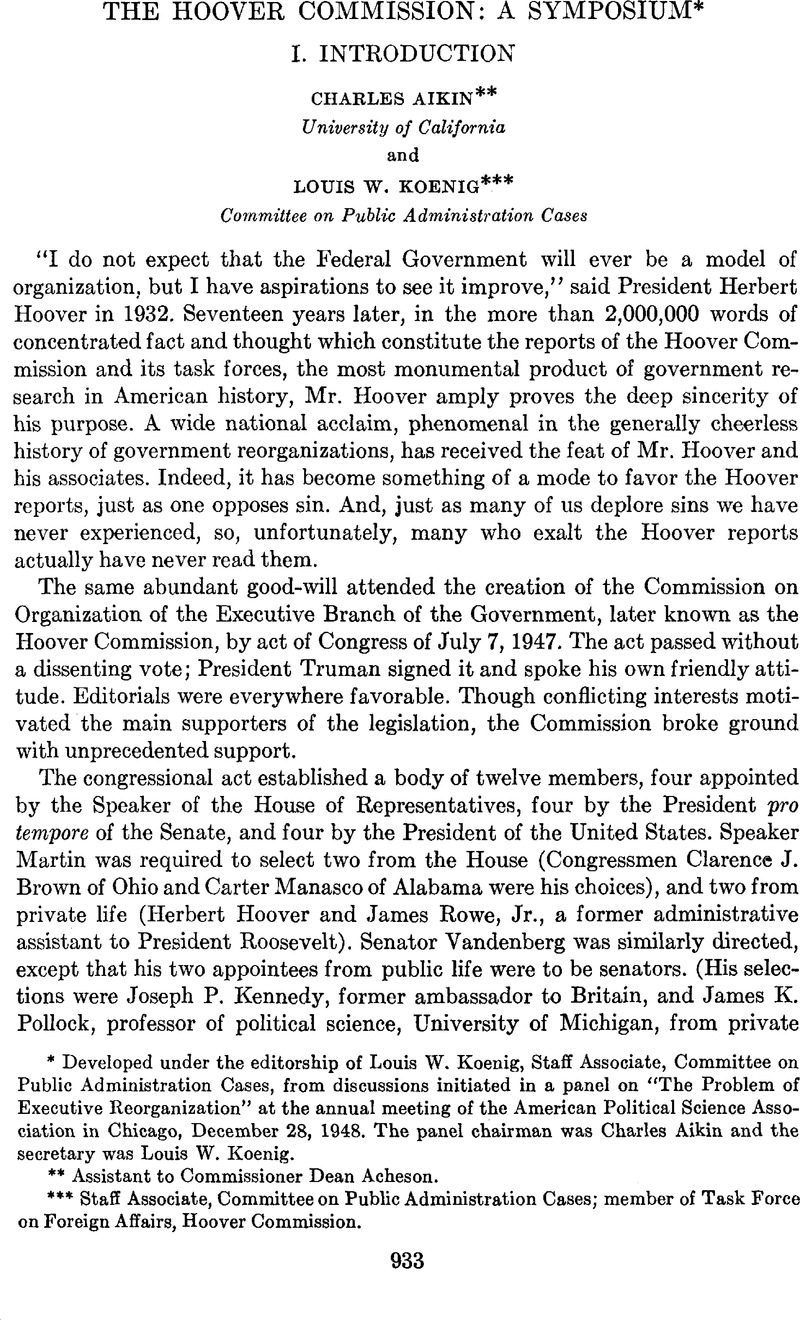Published online by Cambridge University Press: 02 September 2013

1 The other papers in this symposium single out certain important phases of the work of the Commission for analysis and evaluation. For commentaries on the entire series of reports, see Public Affairs Institute, “The Hoover Report: Half a Loaf”, Occasional Paper Series, No. 3, 1949Google Scholar; “Big Government—A Digest of the Reports of the Commission on Organization of the Executive Branch of the Government”, Fortune, Supplement, May, 1949Google Scholar; and “The Reports of the Hoover Commission”, by this writer, in Review of Politics, Vol. 11, pp. 355–378 (July, 1949)CrossRefGoogle Scholar.
2 Numerous proposals have been made for establishment of a National Commission on Intergovernmental Relations; see Joint Hearings before the Subcommittees on Intergovernmental Relations of the Senate and House Committees on Expenditures in the Executive Departments, 81st Cong., 1st Sess., on S. J. 41, S. 767, S. 810, H. R. 2389, H. R. 3184, H. R. 3844, and H. R. 4507 (May 1949). A commission to study administration of overseas affairs has been suggested by Senator McCarthy. Many states have set up or are considering “little Hoover Commissions” for the study of state administrative organization.
3 Public Law 162—80th Cong., 1st Sess. For a fuller discussion of the statutory provisions, see “A New Approach to Federal Executive Reorganization”, by this writer in this Review, Vol. 41 (1947), pp. 1118–1126Google Scholar.
4 Policy statement adopted at Commission meeting on Oct. 20, 1947.
5 The only serious deviation from this policy came in the Commission's Report on Federal Business Enterprises. For comment on this by Commissioners Acheson, Pollock, and Rowe in their dissent, see p. 92 of the report.
6 The names and titles of individuals on the Commission staff appear on pp. 49 and 50 of the Commission's Concluding Report.
7 The task forces, in the order of their creation, were: (1) Presidency and Departmental Management; (2) Post Office; (3) Federal Supply; (4) Transportation; (5) Veterans Affairs; (6) Public Welfare; (7) Fiscal, Budgeting, and Accounting; (8) Federal-State Relationships; (9) Public Works; (10) Federal Field Offices; (11) Revolving Funds and Business Enterprises; (12) Lending Agencies; (13) Federal Personnel Management; (14) Foreign Affairs; (15) Natural Resources; (16) Regulatory Agencies; (17) Agricultural Activities; (18) Public Relations Activities; (19) Medical Services; (20) Indian Affairs; (21) Government Statistical Services; (22) Records Management; (23) National Security Organization; (24) Territories and Dependencies.
8 For example, the reports on Federal Field Services and on Government Information Services. Some other reports were not published because of lack of Commission funds for the purpose.
9 See pp. 106–112 of the report on Business Enterprises for criticisms by three commissioners (Acheson, Pollock, and Rowe) of the task force report on Revolving Funds and Business Enterprises. Senator Aiken, at p. 114, says in a separate statement that the recommendations of this task force report “follow so closely the arguments which the private power interests present in opposition to public water-resource development that the general welfare viewpoint does not seem to be properly represented.” He declared of the task force report on Government Lending Agencies, at p. 113, that it “does not adequately represent the broad public interest viewpoint which motivated the establishment of these agencies.”
Comments
No Comments have been published for this article.